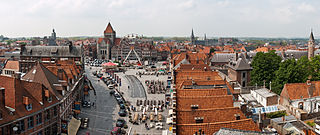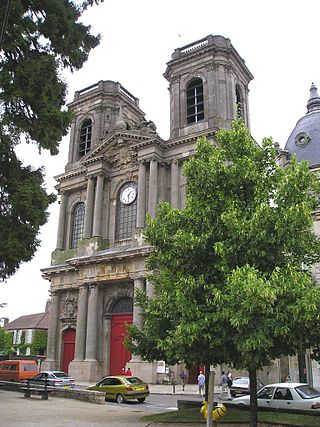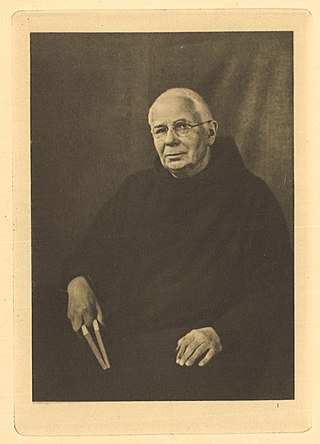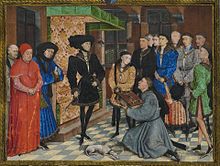
Tournai or Tournay is a city and municipality of Wallonia located in the Province of Hainaut, Belgium. It lies 89 km (55 mi) by road southwest of the centre of Brussels on the river Scheldt, and is part of Eurometropolis Lille–Kortrijk–Tournai, In 2022, the municipality of Tournai had an estimated population of 68,518 people.

Rogier van der Weyden or Roger de la Pasture was an early Netherlandish painter whose surviving works consist mainly of religious triptychs, altarpieces, and commissioned single and diptych portraits. He was highly successful in his lifetime; his paintings were exported to Italy and Spain, and he received commissions from, amongst others, Philip the Good, Netherlandish nobility, and foreign princes. By the latter half of the 15th century, he had eclipsed Jan van Eyck in popularity. However his fame lasted only until the 17th century, and largely due to changing taste, he was almost totally forgotten by the mid-18th century. His reputation was slowly rebuilt during the 200 years that followed; today he is known, with Robert Campin and van Eyck, as the third of the three great Early Flemish artists, and widely as the most influential Northern painter of the 15th century.

Philip III the Good ruled as Duke of Burgundy from 1419 until his death in 1467. He was a member of a cadet line of the Valois dynasty, to which all 15th-century kings of France belonged. During his reign, the Burgundian State reached the apex of its prosperity and prestige, and became a leading centre of the arts.

Jacques Daret was an Early Netherlandish painter born in Tournai, where he would spend much of his life. Daret spent 15 years as a pupil in the studio of Robert Campin, alongside Rogier or Rogelet de le Pasture, and afterwards became a master in his own right. He became a favorite of the Burgundian court, and his patron for 20 years was the abbot of St. Vaast in Arras, Jean de Clercq.

The Diocese of Langres is a Latin Church diocese of the Catholic Church comprising the département of Haute-Marne in France.

The Diocese of Toul was a Roman Catholic diocese seated at Toul in present-day France. It existed from 365 until 1802. From 1048 until 1552, it was also a state of the Holy Roman Empire.

Nicolas Rolin was a leading figure in the history of Burgundy and France, becoming chancellor to Philip the Good.

The Diocese of Nancy and Toul is a Latin Church ecclesiastical territory or diocese of the Catholic Church in France. After a considerable political struggle between Louis XV, Louis XVI, and the Dukes of Lorraine, the diocese was erected by Pope Pius VI on 17 December 1777. The Diocese of Nancy is a suffragan diocese in the ecclesiastical province of the metropolitan Archdiocese of Besançon.

Ferry de Clugny, Cardinal and Bishop of Tournai was a highly placed statesman and ecclesiastic in the service of the Dukes of Burgundy.
The former French diocese of Thérouanne controlled a large part of the left bank of the river Scheldt during the Middle Ages. Territorially it was part of the county of Artois which belonged to the county of Flanders.

The Diocese of Tournai is a Latin Church ecclesiastical territory or diocese of the Catholic Church in Belgium. The diocese was formed in 1146, upon the dissolution of the Diocese of Noyon and Tournai, which had existed since the 7th century. It is now suffragan in the ecclesiastical province of the metropolitan Archdiocese of Mechelen–Brussels. The cathedra is found within the Cathedral of Notre-Dame de Tournai, which has been classified both as a major site for Wallonia's heritage since 1936 and as a World Heritage Site since 2000.

Jean Wauquelin presenting his 'Chroniques de Hainaut' to Philip the Good is a presentation miniature believed to have been painted by the Flemish artist Rogier van der Weyden. It decorates the frontispiece to the Chroniques de Hainaut, MS KBR.9242, Jean Wauquelin's French translation of a three-volume history of the County of Hainaut originally written in Latin by the 14th-century Franciscan historian Jacques de Guyse.

Pasquier Grenier was a Flemish tapestry and wine merchant working in Tournai, and the greater region under the control of the Dukes of Burgundy. Once believed to be a master tapestry weaver, archival documents reveal that he was actually one of the most prominent tapestry dealers of the fifteenth-century in Western Europe, working with tapestry workshops in cities such as Tournai, Bruges, and Antwerp.

Ursmer Berlière, born Alfred Berlière (1861–1932) was a monk of Maredsous Abbey and a monastic historian whose bibliography ran to 360 publications.
Jean de Harcourt was a French priest and bishop.

The Chronicles of Hainaut is an illuminated manuscript in three volumes, tracing the history of the county of Hainaut up to the end of the 14th century. Its text was produced around 1446-1450 by Jean Wauquelin as a French translation of Annales historiae illustrium principum Hannoniæ, a three-volume Latin work produced by Jacques de Guise around 1390-1396. It was made for Philip the Good of Burgundy and is now in the Royal Library of Belgium in Brussels.
Maximilien Villain de Gand (1569–1644) was a bishop of Tournai in the Habsburg Netherlands.

Guillaume Fillastre or Fillâtre was a Burgundian statesman, prelate and patron of arts. He served as a counsellor to Duke Philip the Good and was successively bishop of Verdun (1437–1448), bishop of Toul (1448–1460) and bishop of Tournai (1460–1473). He was also the abbot of Saint-Bertin from 1451 until his death.

The collegiate church of Saint-Pierre was once a large church located in Vieux-Lille, and for almost 750 years it set the pace for Lille's religious life. Seriously damaged during the Austrian siege of 1792, its destruction began in 1794. Its crypt, the only remaining vestige, was listed as a historic monument in 1971.



















